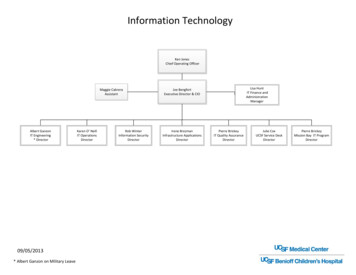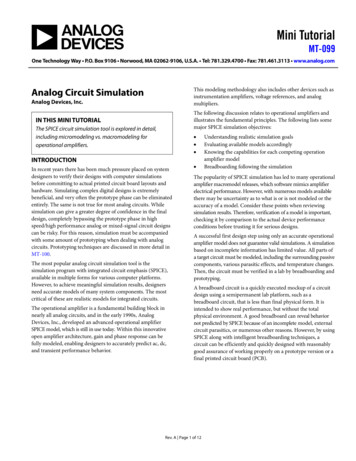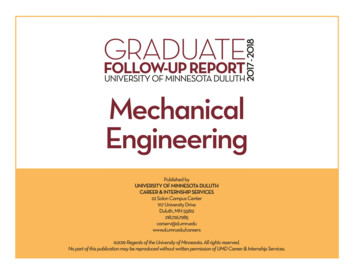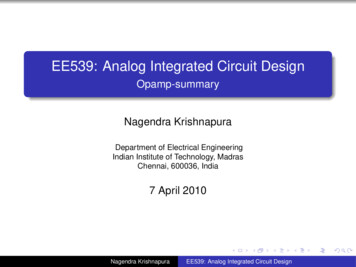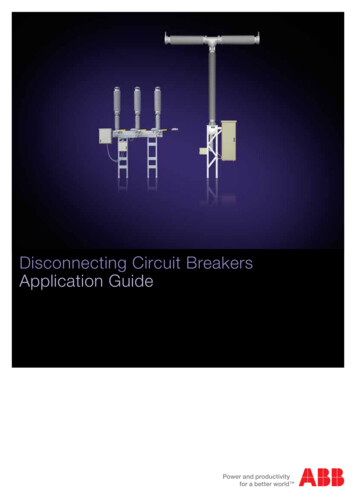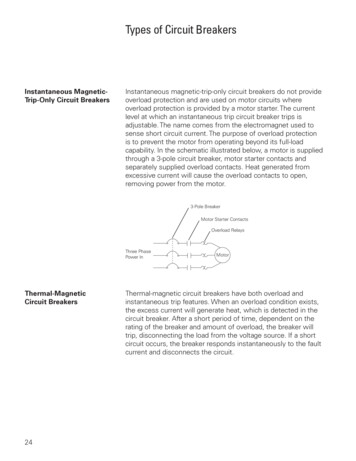
Transcription
Analog Engineer’sCircuit Cookbook: Op Amps
Analog Engineer’s Circuit Cookbook:Op AmpsFirst EditionSLYY137- 03/201803/2018Edited by:Tim Green, Pete Semig and Collin WellsSpecial thanks for technical contribution:Zak KayeErrol LeonTim ClaycombTakahiro SaitoMasashi MiyagawaGustaf Falk OlsonPeter Iliya
Analog Engineer’sCircuit Cookbook: Op Amps(First Edition)Message from the editors:The Analog Engineer’s Circuit Cookbook: Op Amps provides operational amplifier (op amp) sub-circuit ideas that can bequickly adapted to meet your specific system needs. Each circuit is presented as a “definition-by-example.” They includestep-by-step instructions, like a recipe, with formulas enabling you to adapt the circuit to meet your design goals. Additionally,all circuits are verified with SPICE simulations.We’ve provided at least one recommended op amp for each circuit, but you can swap it with another device if you’ve foundone that’s a better fit for your design. You can search our large portfolio of op amps at ti.com/opamps.Our circuits require a basic understanding of op amp concepts. If you’re new to op amp design, we highly recommendcompleting our TI Precision Labs (TIPL) training series. TIPL includes courses on introductory topics, such as devicearchitecture, as well as advanced, application-specific problem-solving, using both theory and practical knowledge. Checkout our curriculum for op amps, ADCs and more at: ti.com/precisionlabs.We hope you find this collection of op amp circuits helpful in developing your designs. Our goal is to regularly updatethe cookbook with valuable op-amp-circuit building blocks. You can check to see if your version is the latest atti.com/circuitcookbooks. If you have input on any of the existing circuits or would like to request additional op ampcookbook circuits for the next edition please contact us at: opampcookbook@list.ti.com.Additional resources to exploreTI Precision Labsti.com/precisionlabs On-demand courses and tutorials ranging from introductory toadvanced concepts that focus on application-specific problem solving Hands-on labs and evaluation modules (EVM) available- TIPL Op Amps experimentation platform, ti.com/TIPL-amp-evm- TIPL SAR ADC experimentation platform, ti.com/TIPL-adc-evmAnalog Engineer’s Pocket Referenceti.com/analogrefguide PCB, analog and mixed-signal design formulae; includes conversions,tables and equations e-book, iTunes app and hardcopy availableThe Signal e-bookti.com/signalbook Op amp e-book with short, bite-sized lessons on design topicssuch as offset voltage, input bias current, stability, noise and moreTI Designsti.com/tidesigns Ready-to-use reference designs with theory, calculations,simulations schematics, PCB files and bench test resultsTINA-TI simulation softwareti.com/tool/tina-ti Complete SPICE simulator for DC, AC, transient and noise analysis Includes schematic entry and post-processor for waveform mathAnalog Wire Blogti.com/analogwire Technical blogs written by analog experts that include tips, tricksand design techniquesTI E2E Communityti.com/e2e Support forums for all TI productsOp Amp Parametric Quick Searchti.com/opamp-search Search for precision, high-speed, general-purpose, ultra-low-power, audioand power op ampsOp Amp Parametric Cross-Referenceti.com/opampcrossreference Find similar TI op amps using competitive part numbersDIY Amplifier Circuit Evaluation Module (DIYAMP-EVM)ti.com/DIYAMP-EVM Single-channel circuit evaluation module providing SC70, SOT23 and SOICpackage options in 12 popular amplifier configurationsDual-Channel DIY Amplifier Circuit Evaluation Module(DUAL-DIYAMP-EVM)ti.com/dual-diyamp-evm Dual-channel circuit evaluation module in an SOIC-8 package with 10popular amplifier configurationsAnalog Engineer’s Calculatorti.com/analogcalc ADC and amplifier design tools, noise and stability analysis,PCB and sensor toolsThe platform bar is a trademark of Texas Instruments. 2018 Texas Instruments Incorporated.
Table of ContentsBasic CircuitsBuffer (Follower) Circuit.5Non-Linear Circuits (Rectifiers/Clamps/PeakDetectors)Inverting Amplifier Circuit.9Half-Wave Rectifier Circuit .70Non-inverting Amplifier Circuit .14Full-Wave Rectifier Circuit .74Inverting Summer Circuit .18Single-Supply, Low-Input Voltage Full-Wave Rectifier Circuit .78Difference Amplifier (Subtractor) Circuit .23Slew Rate Limiter Circuit .82Integrator Circuit.27Differentiator Circuit .32Signal ConditioningSingle-Ended Input to Differential Output Circuit .86Current SensingTransimpedance Amplifier Circuit.37Single-Supply, Low-Side, Unidirectional Current Sensing .Solutionwith Output Swing to GND Circuit .41Low-Side, Bidirectional Current Sensing Circuit .453-Decade, Load Current Sensing Circuit .50Inverting Op Amp With Inverting Positive ReferenceVoltage Circuit .90Non-Inverting Op Amp With Inverting Positive ReferenceVoltage Circuit .94Non-Inverting Op Amp With Non-Inverting Positive ReferenceVoltage Circuit .98Inverting Op Amp With Non-Inverting Positive ReferenceVoltage Circuit .102Signal SourcesPWM Generator Circuit .54ComparatorsComparator With and Without Hysteresis Circuit .106FiltersWindow Comparator Circuit .110AC Coupled (HPF) Inverting Amplifier Circuit .58AC Coupled (HPF) Non-Inverting Amplifier Circuit .62Sensor AcquisitionBand Pass Filtered Inverting Attenuator Circuit .66Photodiode Amplifier Circuit .113Want more circuits? Browse a complete list of op ampand ADC circuitsVisit ti.com/circuitcookbooksAnaloINCircuitVREFGND5.0 V3.0 VAVDD DVDDAnalog Engineer’sCircuit Cookbook: ADCsVinGNDCode Download the Analog Engineer’sCircuit Cookbook for ADCsVing EngCookineerbook:’sOp Amps
Analog Engineer's Circuit: Op AmpsSBOA269 – February 2018Buffer (Follower) CircuitDesign cVee–10V10V–10V10V100kHz15V–15VDesign DescriptionThis design is used to buffer signals by presenting a high input impedance and a low output impedance.This circuit is commonly used to drive low-impedance loads, analog-to-digital converters (ADC) and bufferreference voltages. The output voltage of this circuit is equal to the input voltage.Vee 15- ViVoU1 LM7332Vcc 15Design Notes1. Use op amp linear output operating range, which is usually specified under the AOL test conditions.2. The small-signal bandwidth is determined by the unity-gain bandwidth of the amplifier.3. Check the maximum output voltage swing versus frequency graph in the datasheet to minimize slewinduced distortion.4. The common mode voltage is equal to the input signal.5. Do not place capacitive loads directly on the output that are greater than the values recommended inthe datasheet.6. High output current amplifiers may be required if driving low impedance loads.7. For more information on op amp linear operating region, stability, slew-induced distortion, capacitiveload drive, driving ADCs, and bandwidth please see the Design References section.SBOA269 – February 2018Submit Documentation Feedback5Copyright 2018, Texas Instruments IncorporatedBuffer (Follower) Circuit
www.ti.comDesign StepsThe tranfer function for this circuit is given below.1. Verify that the amplifier can acheive the desired output swing using the supply voltages provided. Usethe output swing stated in the AOL test conditions. The output swing range of the amplifier must begreater than the output swing required for the design. The output swing of the LM7332 using 15-V supplies is greater than the required output swing of thedesign. Therefore, this requirement is met.Review the Output Voltage versus Output Current curves in the product datasheet to verify the desiredoutput voltage can be acheived for the desired output current.2. Verify the input common mode voltage of the amplifier will not be violated using the supply voltageprovided. The input common mode voltage range of the amplifier must be greater than the input signalvoltage range. The input common-mode range of the LM7332 using 15-V supplies is greater than the required inputcommon-mode range of the design. Therefore, this requirement is met.3. Calculate the minimum slew rate required to minimize slew-induced distortion. The slew rate of the LM7332 is 15.2V/µs. Therefore, this requirement is met.4. Verify the device will have sufficient bandwidth for the desired output signal frequency. Buffer (Follower) CircuitThe desired output signal frequency is less than the unity-gain bandwidth of the LM7332. Therefore,this requirement is met.6Copyright 2018, Texas Instruments IncorporatedSBOA269 – February 2018Submit Documentation Feedback
www.ti.comDesign SimulationsDC Simulation ResultsT108Output Voltage (V)6420-2-4-6-8-10-10-8-6-4-202Input voltage (V)46810AC Simulation ResultsT0-3dB BW 7.4MHzGain (dB)-5-10-15-2010100SBOA269 – February 2018Submit Documentation Feedback1k10k100kFrequency (Hz)1MEG7Copyright 2018, Texas Instruments Incorporated10MEG100MEGBuffer (Follower) Circuit
www.ti.comDesign ReferencesSee TIPD128, www.ti.com/tool/tipd128For more information on many op amp topics including common-mode range, output swing, bandwidth,slew rate, and how to drive an ADC please see TI Precision Labs.Design Featured Op AmpLM7332Vss2.5V to b1µAUGBW7.5MHz ( 5-V 332Design Alternate Op AmpOPA192Vss4.5V to 5pAUGBW10MHzSR20V/µs1, 2, 4#Channelswww.ti.com/product/opa192Buffer (Follower) Circuit8Copyright 2018, Texas Instruments IncorporatedSBOA269 – February 2018Submit Documentation Feedback
Analog Engineer's Circuit: Op AmpsSBOA270 – February 2018Inverting Amplifier CircuitDesign cVee–7V7V–14V14V3kHz15V–15VDesign DescriptionThis design inverts the input signal, Vi, and applies a signal gain of –2V/V. The input signal typicallycomes from a low-impedance source because the input impedance of this circuit is determined by theinput resistor, R1. The common-mode voltage of an inverting amplifier is equal to the voltage connected tothe non-inverting node, which is ground in this design.R1 10kR2 20k VccViVeeVcc 15 Vee 15 VoU1 TLV170VccVeeCopyright 2018, Texas Instruments IncorporatedDesign Notes1. Use the op amp in a linear operating region. Linear output swing is usually specified under the AOL testconditions. The common-mode voltage in this circuit does not vary with input voltage.2. The input impedance is determined by the input resistor. Make sure this value is large when comparedto the source's output impedance.3. Using high value resistors can degrade the phase margin of the circuit and introduce additional noisein the circuit.4. Avoid placing capacitive loads directly on the output of the amplifier to minimize stability issues.5. Small-signal bandwidth is determined by the noise gain (or non-inverting gain) and op amp gainbandwidth product (GBP). Additional filtering can be accomplished by adding a capacitor in parallel toR2. Adding a capacitor in parallel with R2 will also improve stability of the circuit if high value resistorsare used.6. Large signal performance may be limited by slew rate. Therefore, check the maximum output swingversus frequency plot in the data sheet to minimize slew-induced distortion.7. For more information on op amp linear operating region, stability, slew-induced distortion, capacitiveload drive, driving ADCs, and bandwidth please see the Design References section.SBOA270 – February 2018Submit Documentation Feedback9Copyright 2018, Texas Instruments IncorporatedInverting Amplifier Circuit
www.ti.comDesign StepsThe transfer function of this circuit is given below.1. Determine the starting value of R1. The relative size of R1 to the signal source's impedance affects thegain error. Assuming the signal source's impedance is low (for example, 100Ω), set R1 10kΩ for 1%gain error.2. Calculate the gain required for the circuit. Since this is an inverting amplifier use ViMin and VoMax for thecalculation.3. Calculate R2 for a desired signal gain of –2V/V.4. Calculate the small signal circuit bandwidth to ensure it meets the 3kHz requirement. Be sure to usethe noise gain, or non-inverting gain, of the circuit.5. Calculate the minimum slew rate required to minimize slew-induced distortion. SRTLV170 0.4V/µs, therefore it meets this requirement.6. To avoid stability issues ensure that the zero created by the gain setting resistors and inputcapacitance of the device is greater than the bandwidth of the circuit. Ccm and Cdiff are the common-mode and differential input capacitances of the TLV170, respectively.Since the zero frequency is greater than the bandwidth of the circuit, this requirement is met.Inverting Amplifier Circuit10Copyright 2018, Texas Instruments IncorporatedSBOA270 – February 2018Submit Documentation Feedback
www.ti.comDesign SimulationsDC Simulation ResultsT14.0Voltage (V)7.00.0-7.0-14.0-3.5-7.00.0Input voltage (V)3.57.0AC Simulation ResultsThe bandwidth of the circuit depends on the noise gain, which is 3V/V. The bandwidth is determined bylooking at the –3dB point, which is located at 3dB given a signal gain of 6dB. The simulation sufficientlycorrelates with the calculated value of 400kHz.T6.03Gain (dB)-3dB BW 519kHz-20.001SBOA270 – February 2018Submit Documentation Feedback101001k10kFrequency (Hz)100k11Copyright 2018, Texas Instruments Incorporated1M10MInverting Amplifier Circuit
www.ti.comTransient Simulation ResultsThe output is double the magnitude of the input, and inverted.Voltage (V)T13.990.00-13.990Inverting Amplifier Circuit250u500uTime (s)12Copyright 2018, Texas Instruments Incorporated750u1mSBOA270 – February 2018Submit Documentation Feedback
www.ti.comDesign ReferencesFor more information on many op amp topics including common-mode range, output swing, bandwidth,and how to drive an ADC please visit TI Precision Labs.Design Featured Op AmpTLV170Vss 18V (36V)VinCM(Vee-0.1V) to 1.2MHzSR0.4V/µs1, 2, 4#Channelswww.ti.com/product/tlv170Design Alternate Op AmpLMV358Vss2.7 to 5.5VVinCM(Vee–0.2V) to UGBW1MHzSR1V/µs#Channels1 (LMV321), 2 (LMV358), 4(LMV324)www.ti.com/product/lmv358SBOA270 – February 2018Submit Documentation Feedback13Copyright 2018, Texas Instruments IncorporatedInverting Amplifier Circuit
Analog Engineer's Circuit: Op AmpsSBOA271 – January 2018Non-Inverting Amplifier CircuitDesign �1V1V–10V1015V–15VDesign DescriptionThis design amplifies the input signal, Vi, with a signal gain of 10V/V. The input signal may come from ahigh-impedance source (for example, MΩ) because the input impedance of this circuit is determined bythe extremely high input impedance of the op amp (for example, GΩ). The common-mode voltage of anon-inverting amplifier is equal to the input signal.R2 1.01kR1 9.09kVEE 15VoU1 OPA171 VCC 15ViDesign Notes1. Use the op amp linear output operating range, which is usually specified under the AOL test conditions.The common-mode voltage is equal to the input signal.2. The input impedance of this circuit is equal to the input impedance of the amplifier.3. Using high-value resistors can degrade the phase margin of the circuit and introduce additional noisein the circuit.4. Avoid placing capacitive loads directly on the output of the amplifier to minimize stability issues.5. The small-signal bandwidth of a non-inverting amplifier depends on the gain of the circuit and the gainbandwidth product (GBP) of the amplifier. Additional filtering can be accomplished by adding acapacitor in parallel to R1. Adding a capacitor in parallel with R1 will also improve stability of the circuitif high-value resistors are used.6. Large signal performance may be limited by slew rate. Therefore, check the maximum output swingversus frequency plot in the data sheet to minimize slew-induced distortion.7. For more information on op amp linear operating region, stability, slew-induced distortion, capacitiveload drive, driving ADCs, and bandwidth please see the Design References section.SBOA271 – January 2018Submit Documentation Feedback14Copyright 2018, Texas Instruments IncorporatedNon-Inverting Amplifier Circuit
www.ti.comDesign StepsThe transfer function for this circuit is given below.1. Calculate the gain.2. Calculate values for R1 and R2.3. Calculate the minimum slew rate required to minimize slew-induced distortion. The slew rate of the OPA171 is 1.5V/µs, therefore it meets this requirement.4. To maintain sufficient phase margin, ensure that the zero created by the gain setting resistors andinput capacitance of the device is greater than the bandwidth of the circuit. Ccm and Cdiff are the common-mode and differential input capacitances of the OPA171, respectively.Since the zero frequency is greater than the bandwidth of the circuit, this requirement is met.Non-Inverting Amplifier Circuit15Copyright 2018, Texas Instruments IncorporatedSBOA271 – January 2018Submit Documentation Feedback
www.ti.comDesign SimulationsDC Simulation ResultsT108Output Voltage (V)6420-2-4-6-8-10-1-750m-500m-250m0Input voltage (V)250m500m750m1AC Simulation ResultsT2010-3dB BW 323.2kHzGain (dB)0-10-20-30-4010100SBOA271 – January 2018Submit Documentation Feedback1k10k100kFrequency (Hz)1MEG16Copyright 2018, Texas Instruments Incorporated10MEG100MEGNon-Inverting Amplifier Circuit
www.ti.comDesign ReferencesFor more information on many op amp topics including common-mode range, output swing, andbandwidth please visit TI Precision Labs.Design Featured Op AmpOPA171Vss2.7V to 36VVinCM(Vee–0.1V) to BW3MHzSR1.5V/µs1, 2, 4#Channelswww.ti.com/product/opa171Design Alternate Op AmpOPA191Vss4.5V to AIb5pAUGBW2.5MHzSR7.5V/µs1, 2, 4#Channelswww.ti.com/product/OPA191Non-Inverting Amplifier Circuit17Copyright 2018, Texas Instruments IncorporatedSBOA271 – January 2018Submit Documentation Feedback
Analog Engineer's Circuit: Op AmpsSBOA272 – February 2018Inverting Summer CircuitDesign GoalsInput 1Input 5VDesign DescriptionThis design sums (adds) and inverts two input signals, Vi1 and Vi2. The input signals typically come fromlow-impedance sources because the input impedance of this circuit is determined by the input resistors,R1 and R2. The common-mode voltage of an inverting amplifier is equal to the voltage connected to thenon-inverting node, which is ground in this design.R3 20kVcc R2 2.05k Vcc 5- Vi2Vee 5VeeR1 20.5kVoVi1 U1 TLV170VccVeeCopyright 2018, Texas Instruments IncorporatedDesign Notes1. Use the op amp in a linear operating region. Linear output swing is usually specified under the AOL testconditions. The common-mode voltage in this circuit does not vary with input voltage.2. The input impedance is determined by the input resistors. Make sure these values are large whencompared to the output impedance of the source.3. Using high-value resistors can degrade the phase margin of the circuit and introduce additional noisein the circuit.4. Avoid placing capacitive loads directly on the output of the amplifier to minimize stability issues.5. Small-signal bandwidth is determined by the noise gain (or non-inverting gain) and op amp gainbandwidth product (GBP). Additional filtering can be accomplished by adding a capacitor in parallel toR3. Adding a capacitor in parallel with R3 will also improve stability of the circuit if high-value resistorsare used.6. Large signal performance may be limited by slew rate. Therefore, check the maximum output swingversus frequency plot in the data sheet to minimize slew-induced distortion.7. For more information on op amp linear operating region, stability, slew-induced distortion, capacitiveload drive, driving ADCs, and bandwidth please see the Design References section.SBOA272 – February 2018Submit Documentation Feedback18Copyright 2018, Texas Instruments IncorporatedInverting Summer Circuit
www.ti.comDesign StepsThe transfer function for this circuit is given below.1. Select a reasonable resistance value for R3.2. Calculate gain required for Vi1. For this design, half of the output swing is devoted to each input.3. Calculate the value of R1.4. Calculate gain required for Vi2. For this design, half of the output swing is devoted to each input.5. Calculate the value of R2.6. Calculate the small signal circuit bandwidth to ensure it meets the 10-kHz requirement. Be sure to usethe noise gain (NG), or non-inverting gain, of the circuit. When calculating the noise gain note that R1and R2 are in parallel. This requirement is met because the closed-loop bandwidth is 102kHz and the design goal is 10kHz.7. Calculate the minmum slew rate to minimize slew-induced distortion. SROPA170 0.4V/µs, therefore it meets this requirement.8. To avoid stability issues ensure that the zero created by the gain setting resistors and inputcapacitance of the device is greater than the bandwidth of the circuit. Ccm and Cdiff are the common-mode and differential input capacitances.Since the zero frequency is greater than the bandwidth of the circuit, this requirement is met.Inverting Summer Circuit19Copyright 2018, Texas Instruments IncorporatedSBOA272 – February 2018Submit Documentation Feedback
www.ti.comDesign SimulationsDC Simulation ResultsThis simulation sweeps Vi1 from –2.5V to 2.5V while Vi2 is held constant at 0V. The output is inverted andranges from –2.44V to 2.44V.T2.5Vi2 held constant (0V)Vi1 swept from -2.5V to 2.5VVoltage (V)Vo 2.44V0.0Vo -2.44V-2.50.0Input voltage (Vi1)-2.52.5This simulation sweeps Vi2 from –250mV to 250mV while Vi1 is held constant at 0V. The output is invertedand ranges from –2.44V to 2.44V.T2.5Vi1 held constant (0V)Vi2 swept from -250mV to 250mVVoltage (V)Vo 2.44V0.0Vo -2.44V-2.5-250.00mSBOA272 – February 2018Submit Documentation Feedback0.00Input voltage (Vi2)20Copyright 2018, Texas Instruments Incorporated250.00mInverting Summer Circuit
www.ti.comAC Simulation ResultsThis simulation shows the bandwidth of the circuit. Note that the bandwidth is the same for either input.This is because the bandwidth depends on the noise gain of the circuit, not the signal gain of each input.These results correlate well with the calculations.T20Vi2G 19.79dB 9.76V/VBW 114.7kHzVi1G -0.21dB 0.98V/VBW 114.86kHzGain (dB)0-20-40101001k10kFrequency (Hz)100k1M10MTransient Simulation ResultsThis simulation shows the inversion and summing of the two input signals. Vi1 is a 1-kHz, 5-Vpp sine waveand Vi2 is a 10-kHz, 500-mVpp sine wave. Since both inputs are properly amplified or attenuated, theoutput is within o-4.840.00Inverting Summer Circuit1.50mTime (s)21Copyright 2018, Texas Instruments Incorporated3.00mSBOA272 – February 2018Submit Documentation Feedback
www.ti.comDesign ReferencesFor more information on many op amp topics including common-mode range, output swing, bandwidth,and how to drive an ADC please visit TI Precision Labs.Design Featured Op AmpOPA170Vss2.7V to 36VVinCM(Vee-0.1V) to 1.2MHzSR0.4V/µs1, 2, 4#Channelswww.ti.com/product/opa170Design Alternate Op AmpLMC7101Vss2.7V to product/lmc7101SBOA272 – February 2018Submit Documentation Feedback22Copyright 2018, Texas Instruments IncorporatedInverting Summer Circuit
Analog Engineer's Circuit: Op AmpsSBOA274 – February 2018Difference Amplifier (Subtractor) CircuitDesign GoalsInput (Vi2-Vi1)OutputCMRR f–1.25V1.25V–2.5V2.5V502.75V–2.75V0VDesign DescriptionThis design inputs two signals, Vi1 and Vi2, and outputs their difference (subtracts). The input signalstypically come from low-impedance sources because the input impedance of this circuit is determined bythe resistive network. Difference amplifiers are typically used to amplify differential input signals and rejectcommon-mode voltages. A common-mode voltage is the voltage common to both inputs. Theeffectiveness of the ability of a difference amplifier to reject a common-mode signal is known as commonmode rejection ratio (CMRR). The CMRR of a difference amplifier is dominated by the tolerance of theresistors.R2 10kVccVcc 2.75 Vee 2.75Vi2VrefR4 20kVref Vcc Vref 0 - VoU1 TLV6001VeeVeeVi1R1 10k R3 20kCopyright 2018, Texas Instruments IncorporatedDesign Notes1. Use the op amp in a linear operating region. Ensure that the inputs of the op amp do not exceed thecommon-mode range of the device. Linear output swing is usually specified under the AOL testconditions.2. The input impedance is determined by the input resistive network. Make sure these values are largewhen compared to the output impedance of the sources.3. Using high-value resistors can degrade the phase margin of the circuit and introduce additional noisein the circuit.4. Avoid placing capacitive loads directly on the output of the amplifier to minimize stability issues.5. Small-signal bandwidth is determined by the noise gain (or non-inverting gain) and op amp gainbandwidth product (GBP). Additional filtering can be accomplished by adding a capacitors in parallel toR3 and R4. Adding capacitors in parallel with R3 and R4 will also improve stability of the circuit if highvalue resistors are used.6. Large signal performance may be limited by slew rate. Therefore, check the maximum output swingversus frequency plot in the data sheet to minimize slew-induced distortion.7. For more information on op amp linear operating region, stability, slew-induced distortion, capacitiveload drive, driving ADCs, and bandwidth please see the Design References section.SBOA274 – February 2018Submit Documentation Feedback23Copyright 2018, Texas Instruments IncorporatedDifference Amplifier (Subtractor) Circuit
www.ti.comDesign StepsThe complete transfer function for this circuit is shown below.If R1 R2 and R3 R4 the transfer function for this circuit simplifies to the following equation. Where the gain, G, is R3/R1.1. Determine the starting value of R1 and R2. The relative size of R1 and R2 to the signal impedance of thesource affects the gain error.2. Calculate the gain required for the circuit.3. Calculate the values for R3 and R4.4. Calculate resistor tolerance to meet the minimum common-mode rejection ratio (CMRR). For minimum(worst-case) CMRR, α 4. For a more probable, or typical value of CMRR, α 0.33.5. For quick reference, the following table compares resistor tolerance to minimum and typical CMRRvalues assuming G 1 or G 2. As shown above, as gain increases so does CMRR.ToleranceG 1 Minimum (dB)G 1 Typical (dB)G 2 Minimum (dB)G 2 Typical (dB)0.01% 0.00017495.677.599.20.1% 0.0015475.657.579.20.5% 0.0054061.643.565.21% 0.013455.637.559.25% 0.052041.623.545.2Difference Amplifier (Subtractor) Circuit24Copyright 2018, Texas Instruments IncorporatedSBOA274 – February 2018Submit Documentation Feedback
www.ti.comDesign SimulationsDC Simulation ResultsT2.5Vdiff -250.00m250.00mInput voltage (Vdiff)750.00m1.25CMRR Simulation ResultsT-40Gain (dB)Worst Case CMRR -51.11dBData sheets typically depict CMRR asa positive number.-60This value is referred to the output.To refer to input, subtract the gain in dB,which is 6dB (2V/V). Actual CMRRreferred to the input is therefore -57.11dB-802010Frequency (Hz)SBOA274 – February 2018Submit Documentation Feedback25Copyright 2018, Texas Instruments IncorporatedDifference Amplifier (Subtractor) Circuit
www.ti.comDesign ReferencesFor more information on many op amp topics including common-mode range, output swing, bandwidth,and how to drive an ADC please visit TI Precision Labs. For more information on difference amplifierCMRR, please read Overlooking the obvious: the input impedance of a difference amplifier .Design Featured Op AmpTLV6001Vss1.8V to µAIb1pAUGBW1MHzSR0.5V/µs1, 2, 4#Channelswww.ti.com/product/tlv6001Design Alternate Op AmpOPA320Vss1.8V to mAIb0.2pAUGBW20MHzSR10V/µs1, 2#Channelswww.ti.com/product/opa320Difference Amplifier (Subtractor) Circuit26Copyright 2018, Texas Instruments IncorporatedSBOA274 – February 2018Submit Documentation Feedback
Analog Engineer's Circuit: Op AmpsSBOA275 – Februar
Analog Engineer's Circuit Cookbook Op Amps provides operational amplifier (op amp) sub-circuit ideas that can be quickly adapted to meet your specific system needs. Each circuit is presented as a "definition-by-example." They include step-by-step instructions, like a recipe, with formulas enabling you to adapt the circuit to meet your design goals.


